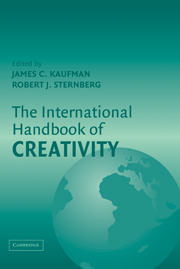Book contents
- Frontmatter
- Contents
- Acknowledgments
- List of Contributors
- 1 Introduction
- 2 Creativity Research in English-Speaking Countries
- 3 Creativity in Latin America
- 4 History of Creativity in Spain
- 5 Past, Present, and Future Perspectives on Creativity in France and French-Speaking Switzerland
- 6 Creativity in Italy
- 7 Creativity Research in German-Speaking Countries
- 8 Creativity Under the Northern Lights
- 9 Creativity in Soviet–Russian Psychology
- 10 Creativity Studies in Poland
- 11 Research on Creativity in Israel
- 12 Creativity in Turkey and Turkish-Speaking Countries
- 13 Development of Creativity Research in Chinese Societies
- 14 Creativity – A Sudden Rising Star in Korea
- 15 Culture and Facets of Creativity
- 16 African Perspectives on Creativity
- 17 Creativity Around the World in 80 Ways … but with One Destination
- Author Index
- Subject Index
- References
12 - Creativity in Turkey and Turkish-Speaking Countries
Published online by Cambridge University Press: 05 June 2012
- Frontmatter
- Contents
- Acknowledgments
- List of Contributors
- 1 Introduction
- 2 Creativity Research in English-Speaking Countries
- 3 Creativity in Latin America
- 4 History of Creativity in Spain
- 5 Past, Present, and Future Perspectives on Creativity in France and French-Speaking Switzerland
- 6 Creativity in Italy
- 7 Creativity Research in German-Speaking Countries
- 8 Creativity Under the Northern Lights
- 9 Creativity in Soviet–Russian Psychology
- 10 Creativity Studies in Poland
- 11 Research on Creativity in Israel
- 12 Creativity in Turkey and Turkish-Speaking Countries
- 13 Development of Creativity Research in Chinese Societies
- 14 Creativity – A Sudden Rising Star in Korea
- 15 Culture and Facets of Creativity
- 16 African Perspectives on Creativity
- 17 Creativity Around the World in 80 Ways … but with One Destination
- Author Index
- Subject Index
- References
Summary
Creativity in Turkey and Turkish-speaking countries in the Balkans and Turkish Republic is very colorful. In the Anatolia peninsula, hundreds of ethnicities and subcultures have mingled with each other, each protecting its own identity, for thousands of years. Turkey is surrounded by Russia (which at present includes Turkish republics such as Azerbaijan, Kyrgyzstan, Kazakhstan, and Uzbekistan), Iraq, Iran, and Syria to the east and south, and Bulgaria and Greece to the west.
Most of the Balkan countries include Turkish minorities and Muslims, such as those who live in Bosnia and Herzegovina, Croatia, Kosovo, Albania, Montenegro, and some parts of Greece and Bulgaria. Within this mosaic, the concept of creativity reflects a deep synthesis of Western and Eastern values.
It is useful to examine how fantasy is perceived in Turkish culture. The Turkish synonym for fantasy, hayal, originates from the Arabic word heyl. Interestingly, heyl means horse in Arabic. Thus in Turkish culture, fantasy could be described as a horse that takes its rider far away beyond the boundaries of the universe.
Today, there seem to exist two main approaches to the importance and function of fantasy within the creative process. One approach was developed by Ahmet İnam, a Turkish philosophy professor at Middle East Technical University, in Ankara. İnam (1996, p. 14) claims that fantasy is the main source of thought.
- Type
- Chapter
- Information
- The International Handbook of Creativity , pp. 337 - 373Publisher: Cambridge University PressPrint publication year: 2006
References
- 6
- Cited by



